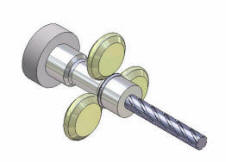|
Page 1 | Page 2 |
Page 3 | Page 4 |
|
|
|
|
Trial Court
Rules in Favor of AFTE and Named Defendants
In December of 2006 a Trial
Court ruled in favor of the Association of Firearm and Tool Mark
Examiners (AFTE) and named defendants in a lawsuit filed by AFTE
member Paul Dougherty. Judgment was entered in favor of AFTE and
the named defendants in January of 2007.
Thereafter, Mr. Paul Dougherty appealed the Trial Court decision
to the California Court of Appeal. On July 27, 2008, the
Court of Appeal issued a unanimous decision affirming the Trial
Court and awarding AFTE and the named defendants their cost on
Appeal.
The Appeals court summarized their ruling by stating,
"Stepping back from this appeal, however, there is something
very heartening about this case: A private organization
whose purpose is to ensure the integrity of expert testimony
actually had the gumption to censure a member whose
testimony bordered on the ludicrous -- roughly the
equivalent of saying that a shotgun can shoot at a right
angle. The organization painstakingly gave the errant member
multiple opportunities to explain why his testimony wasnít
as bad as it looked, and ultimately, after about four years
of internal due process, his peers censured him. In our
opinion, they didnít deserve a lawsuit, they deserve a
medal."
Read the full ruling by clicking here... (99k
pdf file)
|
|
Micro Serialized Firing Pin
StudyWhat Micro
Serialized Firing Pins Can Add to Firearm Identification in
Forensic Science: How Viable are Micro-Marked Firing Pin
Impressions as Evidence?
by David Howitt, PhD, Frederic A.
Tulleners, and Michael T. Beddow Forensic Science Graduate
Group University of California, Davis
From the Executive Summary:
"Every time a semiautomatic firearm is discharged, a bullet will
leave the barrel and the cartridge case, which initially
contained the bullet and powder charge will be ejected from the
firearm. During the discharging process, working surfaces inside
the firearm impart microscopic markings onto various areas of
each bullet and cartridge case. One of these working surfaces is
the firing pin, an object that strikes the primer surface in the
base or back of the cartridge case, thereby causing the powder
charge to deflagrate and fire the bullet. These ejected
cartridge cases are one of the key pieces of evidence used in
solving firearm-related crimes. More precisely, it is the
microscopic markings, such as those impressed onto the back of
the cartridge case by the firing pin, that forensic firearms
examiners scrutinize in order to determine whether an
identification with the crime gun can be made.
This examination
and comparison process is highly meticulous, time consuming and
requires a forensic scientist with specialized equipment,
training and experience.
 The transfer of intentional
microscopic impressions of intentional microscopic marking from
the working surfaces of a firearm to each fired cartridge case
was the goal behind the recent development of a micro-machining
technology designed to machine an array of microscopic
characters onto the face of a firing pin. The surface area of a
firing pin is sufficiently large enough for a wide variety of
alphanumeric characters, symbols, barcode lines, or other
encoding structures to be machined on it. Todd Lizotte of ID
Dynamics, located in Londonderry, New Hampshire, developed a
micro-machining method that utilizes an ultraviolet laser to
engrave micro-encoding structures onto firing pins. The method
is similar to that used to engrave codes on computer chips..." The transfer of intentional
microscopic impressions of intentional microscopic marking from
the working surfaces of a firearm to each fired cartridge case
was the goal behind the recent development of a micro-machining
technology designed to machine an array of microscopic
characters onto the face of a firing pin. The surface area of a
firing pin is sufficiently large enough for a wide variety of
alphanumeric characters, symbols, barcode lines, or other
encoding structures to be machined on it. Todd Lizotte of ID
Dynamics, located in Londonderry, New Hampshire, developed a
micro-machining method that utilizes an ultraviolet laser to
engrave micro-encoding structures onto firing pins. The method
is similar to that used to engrave codes on computer chips..."
Read the Full Report (582 KB pdf)
|
|
Rifling Data Search 8
Rifling Data Search
8
is the latest version of the rifling search database
application for Microsoft Access 2000, XP, 2003, or
2007.
This
version updates the data to include all data contained in the
2008 FBI GRC release.
If you are a firearm examiner and don't have access to the new federally released
database you may find this database very helpful in casework. However, this application
is not being released publicly.
Please submit a request for this application via the
Help Desk.
If you are not a Firearm and Toolmark Examiner
DO NOT BOTHER ASKING FOR
THIS APPLICATION. I will not
respond unless I can verify you work in the
discipline.
I reserve the right to limit the availability of this database
application. All
requests will be considered but I cannot guarantee your request will be approved.
Delivery of the database will be via an
approximately 2.6 MB downloadable .exe file or
.zip file.
|
|
 Rifling By
Flow Forming Rifling By
Flow Forming
by BARIŞ G‹N and ILHAN G‹VEL"Flow forming of a barrel can be described as
a special application of forward flow forming which is used to
form grooves and lands inside the barrel while also forming
outside of the barrel."
"In rifling by flow forming, a barrel preform
over a special mandrel containing reverse image of desired
grooves and lands are flow formed by rollers. During the
process, the barrel material flows in axial and radial
directions. Axial flow elongates the barrel and radial flow
forms the rifling."
Read More...
|
|
|
Page 1 | Page 2 |
Page 3 |Page 4
|
|
|
|